by Vincent N. Darlage, Ph.D.
“‘Listen, my lord. I was a great sorcerer in the south. Men spoke of Thoth-amon as they spoke of Rammon. King Ctesphon of Stygia gave me great honor, casting down the magicians from the high places to exalt me above them. They hated me, but they feared me, for I controlled beings from outside which came at my call and did my bidding. By Set, mine enemy knew not the hour when he might awake at midnight to feel the taloned fingers of a nameless horror at his throat! I did dark and terrible magic with the Serpent Ring of Set, which I found in a nighted tomb a league beneath the earth, forgotten before the first man crawled out of the slimy sea.”
Robert E. Howard, “The Phoenix on the Sword”
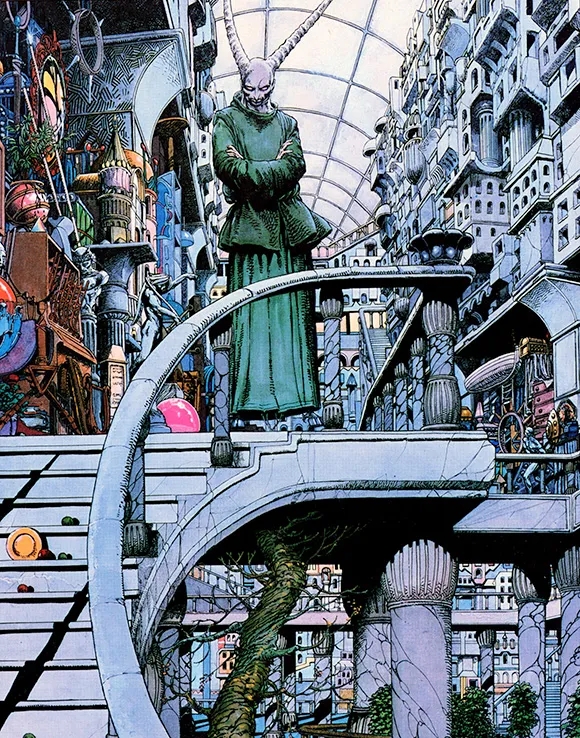
Thoth-amon is commonly considered Conan’s arch-enemy, but in Robert E. Howard’s stories, he simply was not. Yes, he was in “Phoenix on the Sword,” the first Conan story; however, he wasn’t trying to kill Conan. He didn’t give a shit about Conan. Thoth-amon wanted to kill Ascalante. The only reason Conan was in danger was because of the last thing Thoth-amon said to his baboon-like demon, “and all with him!”
Thoth-amon was the slave of Ascalante and when he found his Ring again, he wanted Ascalente dead. And the “all with him” was just icing on the cake. With this story we find a wonderful antagonist, and his attack was about his enslaver. That his enslaver was attacking Conan at the time was incidental. I reject the idea that Thoth-amon considered Conan an enemy at all.
However, my opinion doesn’t matter at all. The world turns in its own way regardless of my opinions on just about any matter. Thus, it turns with Thoth-amon, who would, in due course, become Conan’s nemesis in pop-culture.
The Phoenix on the Sword
“Thoth-amon’s eyes narrowed. For all his iron-self-control, he was near bursting with long pent-up shame, hate and rage, ready to take any sort of a desperate chance. What he did not reckon on was the fact that Dion saw him, not as a human being with a brain and a wit, but simply a slave, and as such, a creature beneath notice.”
Robert E. Howard, “The Phoenix on the Sword”
Thoth-amon first appeared in “The Phoenix on the Sword.” It’s also the first Conan story, and well known as a rewrite of an unsold King Kull story, “By This Axe I Rule.” The Kull story did not have Thoth-amon in it, nor counterpart to the sorcerer-turned-slave. There was no demon of the Ring or anything of the sort. These elements would be added only in the Conan version of the story, an addition of supernatural elements needed for Weird Tales.
As I mentioned in the introduction, Thoth-amon is not angry with Conan nor is he Conan’s opponent in “The Phoenix on the Sword.” He is a slave of Ascalante. He was once a powerful sorcerer and priest in Stygia, but he lost his precious Serpent Ring of Set – which weakened him and allowed rival priests to overthrow him and sell him into slavery. Somehow Dion, the fat baron of Attalus, bought the Serpent Ring from a thief and considered it a good luck charm. Thoth-amon slew Dion, took back his ring, and summoned the haunter of the Ring to slay his enslaver, Ascalante. That King Conan was in the room with Ascalante was mere happenstance.
Thoth-amon is shown to be an intelligent observer and a wise advisor. Whenever he is under another’s power, whether through sorcery or blackmail, he is always careful to gain leverage and gather magical links to one day turn the tables on his oppressor; in this story he kept one of Ascalante’s sandals with him. When he makes an enemy, he is unlikely to rest until that enemy is painfully dead. “The Phoenix on the Sword” also establishes that Thoth-amon needs his Ring to be powerful. When it was stolen, he was overthrown by others. One wonders what became of Thoth-amon when the fiend was slain by Conan – if it truly was slain.
The God in the Bowl
“’I found a symbol on the bottom of the Bowl!’ chattered Promero. ‘Not an ancient hieroglyphic, but a symbol recently carved! The mark of Thoth-amon, the Stygian sorcerer, Kalanthes’ deadly foe!’”
Robert E. Howard, “The God in the Bowl”
Thoth-amon is mentioned again in “The God in the Bowl,” identified as the deadly foe of Kalanthes, the priest of Ibis. Again, he is not after Conan, but someone else entirely (the afore-mentioned Kalanthes). This story is in Conan’s youth. “The Phoenix on the Sword” is in Conan’s middle years. An REH purist would not find any other interactions between Conan and Thoth-amon, and wouldn’t consider Thoth-amon to be Conan’s greatest enemy. Conan and Thoth-amon don’t even meet in any Robert E. Howard story.
The Hour of the Dragon
“’Men say that he has opposed Thoth-amon, who is the master of all priests of Set, and dwells in Luxur, and that Thutothmes seeks hidden power to overthrow the Great One. But who am I to say? When priests war with one another a common man can but lie on his belly and hope neither treads upon him.’”
Robert E. Howard, The Hour of the Dragon
Thoth-amon does not appear in The Hour of the Dragon, but he is mentioned. “Only occultists high in the mazes of the hideous Black Ring possessed the power of the black hand that dealt death by its touch; and only such a man would dare defy Thoth-Amon, whom the western world knew only as a figure of terror and myth.” Thoth-amon is a monster in Stygia, and it takes someone of great power to openly defy him. Thutothmes of Khemi is such a someone. He discusses Thoth-amon in more detail in the following quote:
“Ask me not how I, Thutothmes of Khemi and the Night, heard the word before Thoth-Amon who calls himself prince of all wizards. There are secrets not meet for such ears even as yours, and Thoth-Amon is not the only lord of the Black Ring.
“I knew, and I went to meet the Heart which came southward. It was like a magnet which drew me, unerringly. From death to death it came, riding on a river of human blood. Blood feeds it, blood draws it. Its power is greatest when there is blood on the hands that grasp it, when it is wrested by slaughter from its holder. Wherever it gleams, blood is spilt and kingdoms totter, and the forces of nature are put in turmoil. “And here I stand, the master of the Heart, and have summoned you to come secretly, who are faithful to me, to share in the black kingdom that shall be. Tonight you shall witness the breaking of Thoth-Amon’s chains which enslave us, and the birth of empire.”
However, these three Conan stories were not the only times Robert E. Howard wrote of Thoth-amon…
Marchers of Valhalla (Draft)
“Listen, and I will tell you!” she cried, hitching toward me on her knees and catching at the skirt of my tunic. “Only listen, and then grant me the little thing I ask! I am Ishtar, a daughter of a king in dim Lemuria, which the sea gulped so long ago. Thoth-amon, the sorcerer of Stygia, hated my father, and to spite him, he put the curse on me of Life ever-lasting!”
Robert E. Howard, Marchers of Valhalla (Draft)
In one of the drafts of Marchers of Valhalla, Robert E. Howard references Thoth-amon, the sorcerer of Stygia. In this draft, Ishtar claims Thoth-amon had the ability to curse people with eternal life, and that she was the recipient of this curse.
The Haunter of the Ring
“’I knew as soon as I saw the ring on Evelyn Gordon’s finger; the ring she could not remove; the ancient and accursed ring of Thoth-amon, handed down by foul cults of sorcerers since the days of forgotten Stygia.’”
Robert E. Howard, “The Haunter of the Ring”
When I discovered “The Haunter of the Ring,” I was beyond surprised. That story mesmerized me. It’s probably most easily found in The Horror Stories of Robert E. Howard, the Del Rey edition, page 410. For me, I discovered it with Beyond the Borders, Baen, October 1996. Unlike most of the stories involving Thoth-amon, this one takes place in the 1920s-1930s. John Kirowan’s friend, James Gordon, has arrived, with a tale of a mysterious ring, possibly found in Hungary, that was sent to his wife, Evelyn. She cannot get this ring off her finger. It is described as “copper, made like a scaly snake coiled three times, with its tail in its mouth and yellow jewels for eyes.”
The ring causes her to dream of a horrible faceless black thing that mumbles and paws over her with apish hands… and during the day, she tries to kill her husband, Jim Gordon (not the police commissioner of Gotham, just the same name). Kirowan leads the narrator (Michael O’Donnel) to their enemy, Joseph Roelocke (aka Yosef Vrolok), a Hungarian with psychic powers who gave Evelyn the ring… a ring revealed to be Thoth-amon’s, which summons a demon more ferocious than all in Hell. Apparently, Conan didn’t kill the demon permanently, or Thoth-amon trapped another demon within it.
The fate of the ring is unclear, however. I suppose Kirowan was able to get it off Evelyn’s finger and then kept it, but where it lurks today, who can say? I think a story of it’s modern-day appearance would be FANTASTIC!
Conan the Buccaneer
“The man was a dusky giant, with broad shoulders and aloof, hawklike features. From his shaven skull to his sandaled feet, his skin was a deep, rich brown. Black eyes glittered hypnotically from the depths of cavernous eye-sockets. He wore a simple white linen robe. The only ornament to be seen on his person was a copper-colored ring, in the form of a serpent that, making three turns around one finger of a muscular hand, held its tail in its jaws.”
L. Sprague de Camp & Lin Carter, Conan the Buccaneer
I am not here to debate the merits or demerits of L. Sprague de Camp or Lin Carter. I was a teenager when I discovered the Ace/Lancer Conan series, and they included pastiches… and I enjoyed those pastiches when I was younger. At the end of Chapter One, a character named Menkara goes to seek Thoth-Amon. L. Sprague de Camp followed Weird Tales editor Farnsworth Wright’s original edit and capitalized the “Amon” portion of the name, whereas Robert E. Howard (in his typescript) did not. Sometimes, de Camp and Carter (undoubtedly a typo) spell his name “Thoth-Ammon,” sometimes in adjacent paragraphs (page 32 of the Ace edition of “Conan the Buccaneer”). I’ll use the de Camp & Carter capitalization for their version of Thoth-Amon.
Thoth-Amon first appears in Chapter 8. He uses magic freely and easily, telekinetically moving things with the snap of his fingers. In Chapter 12, Thoth-Amon can search through the Akashic Plane for people. He appears again in Chapter 14, teleporting in to steal the Cobra Crown. He handwaves the Amazon queen to unconsciousness and teleports back again. His attitude toward Conan is simply, “Thoth-Amon regarded the Cimmerian buccaneer as but a minor annoyance, as one would a buzzing mosquito.”
Thoth-Amon becomes King of Zingara in Chapter 19, but it doesn’t last long, and Thoth-Amon destroys the Cobra Crown. Thoth-Amon turns invisible, uses his Serpent Ring to animate a tapestry, and escapes.
The Treasure of Tranicos
“’He was Thoth-Amon of the Ring, in exile from his native Stygia. He had fled in the reign of King Mentupherra, and when Mentupherra died and Ctesphon ascended the ivory throne of Luxur, Thoth-Amon lingered in Kordava though he might have returned home, dunning me for the debt I owed him. But instead of paying him the moiety of my gains as I had promised, I denounced him to my own monarch, so that Thoth-Amon must needs willy-nilly return to Stygia in haste and stealth.’”
L. Sprague de Camp, “The Treasure of Tranicos”
“The Treasure of Tranicos” is an odd duck to say the least. The story behind how “The Black Stranger” became “Swords of the Red Brotherhood” and then became “The Treasure of Tranicos” is best left for other essays and has been covered many times. While Thoth-amon does not appear in REH’s original “The Black Stranger,” Thoth-Amon does appear in the de Camp-rewritten “The Treasure of Tranicos.”
Thoth-Amon is depicted as Valenso’s enemy in court. De Camp changed the text so the magician Valenso cheated wasn’t killed, but lived… and was none other than Thoth-Amon. Conan slays Thoth-Amon’s demon and supposed Thoth-Amon had slunk off to some Stygian tomb because “these wizards are a queer lot.” Ace also released an illustrated edition of the Treasure of Tranicos, and there is a pretty great picture of Thoth-Amon by Esteban Maroto on page 63.
Even at this stage, Thoth-Amon is not Conan’s enemy per se. He’s always after someone else.
Conan of Aquilonia
“Then the coil of writhing vapor that was Thoth-Amon’s spirit stiffened and writhed in Conan’s impalpable clutch. Thoth-Amon shrieked soundlessly – an awful, hollow cry of agony and despair. The bodiless thing melted in his grasp. It disintegrated and faded into the cold mists of the void.”
L. Sprague de Camp & Lin Carter, “Shadows in the Skull”
Conan of Aquilonia was always an interesting book for me when I was young. Conan is older, and he has a son. This is the book where L. Sprague de Camp and Lin Carter really cemented Thoth-Amon as Conan’s nemesis.
In “The Witch of the Mists,” King Conan discovers that Thoth-Amon is behind the plot to kidnap Conan’s son, Conn.
In “Black Sphinx of Nebthu,” King Conan leads an army into Stygia, into the ancient city of Nebthu, to seek out Thoth-Amon. A druid kept Conan’s army basically invisible to Thoth-Amon’s magical sight. Conan knows Thoth-Amon was behind the demon that attacked in “Phoenix on the Sword.” For his part, Thoth-Amon recounts the events of “The God in the Bowl,” Conan the Buccaneer, “Treasure of Tranicos,” and “Phoenix on the Sword.” Thoth-Amon is surrounded by hundreds of wizards and acolytes. He can shoot green rays from his fingers to knock swords out of hands. Soon, the hundreds of wizards join Thoth-Amon in shooting green rays at Conan and his men, but the White Druid of Pictland defended them with his magic staff. When the druid started to falter, Conan produced the Heart of Ahriman. The Heart of Ahriman killed or drove mad the hundreds of wizards, but Thoth-Amon summoned a giant, demonic black sphinx which slaughtered Conan’s army, but vanished with the coming daylight. Thoth-Amon flees to Zembabwei.
In “Red Moon of Zembabwei,” Thoth-Amon meets with another ally, Nenaunir, a king and fellow wizard. Thoth-Amon captures Conan and Conn, but ultimately must flee southward on a wyvern. This leads into Shadows in the Skull, where Thoth-Amon takes refuge among a remnant colony of serpent-men. The life-force of Thoth-Amon battled the life-force of Conan. Conan and Conn, however, won the day, finally killing their foe.
In this book, Thoth-Amon is shown to use magic almost absent-mindedly, shooting green bolts of eldritch energy with ease. He is also shown to have sorcerous allies and a cult with hundreds of votaries.
Marvel Comics
Marvel Comics leaned into L. Sprague de Camp’s vision of Thoth-Amon as a nemesis for Conan. In their adaptation of “The God in the Bowl” in Conan the Barbarian (CtB) #7, Conan actually gets a visionary glimpse of Thoth-Amon, complete with curled ram’s horns as headgear. In CtB #43, Morophla is worried that Conan might be an assassin sent by Thoth-Amon. In CtB #89, Thoth-Amon is seen blasting apart a door and he takes on an advisory role in the rule of Ctesphon III. Thoth-Amon appears also in The Savage Sword of Conan (SSoC). SSoC #191-193 are notable because chronologically, this is the first time in the Marvel Universe that Conan and Thoth-Amon meet.
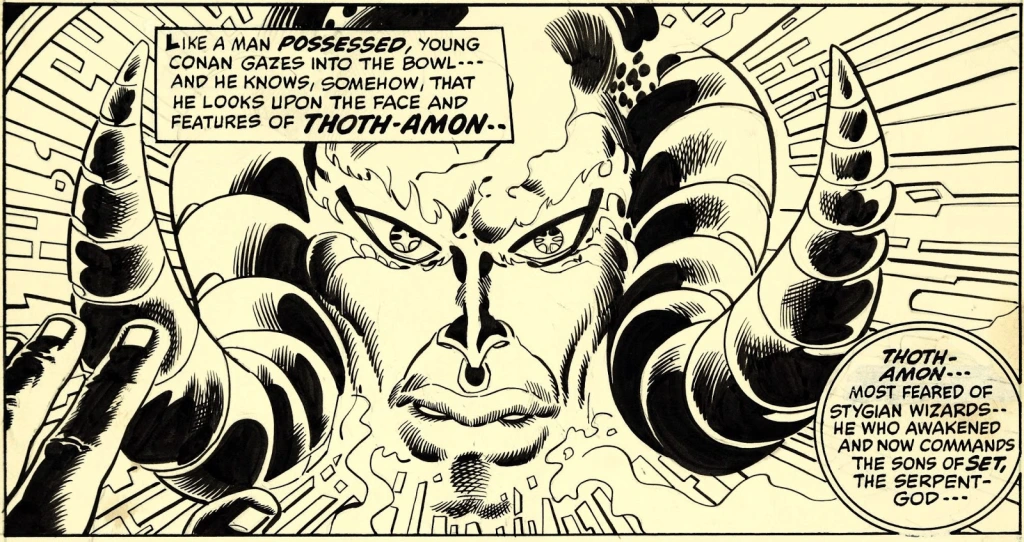
Of course, Thoth-Amon appears in the various adaptations of “The Phoenix on the Sword,” Conan of Aquilonia, and Conan the Buccaneer. I prefer Thoth-Amon bald headed than with the ram’s horn headdress, but it is notable and easily identifiable. Thoth-Amon is generally portrayed as a bad-ass in the Marvel Comics. Effort is made to make him a mighty and fearsome foe.
Marvel Comics ran a Thoth-Amon short story by Matt Forbeck called “The Fall of Thoth-Amon” in Age of Conan: Valeria #1-5. It is a very slight tale that more or less explains how Thoth-Amon lost his ring and became Ascalante’s slave.
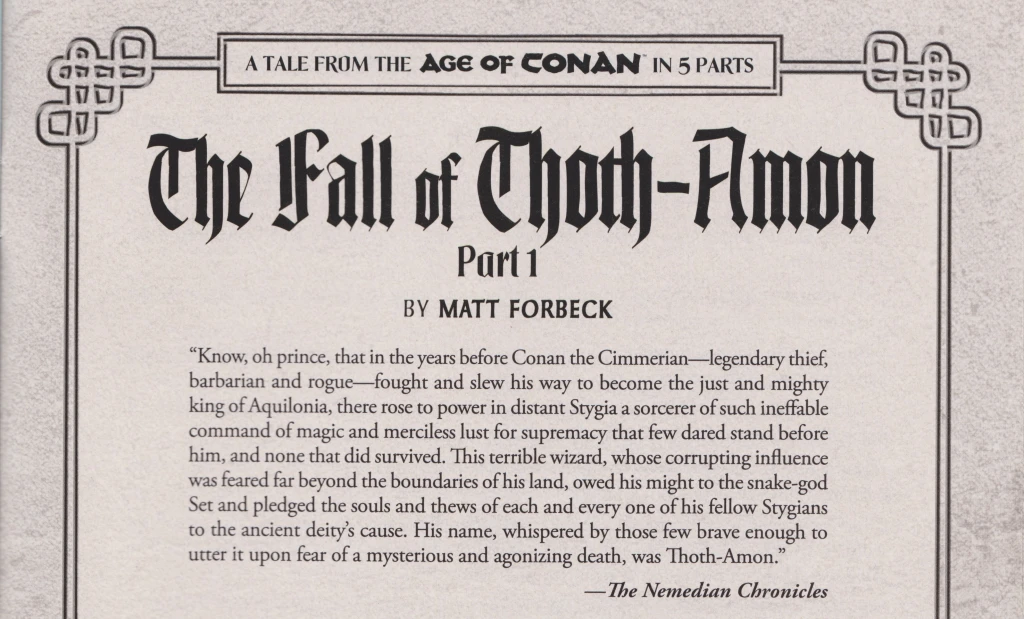
Tor Novels
“Tevek had met Thoth-Amon once, years hence in Nebthu, and that meeting had left a lasting impression. The raw essence of evil had pervaded the very air about Thoth-Amon, whose mere presence had cowed the haughty priests of Nebthu. Tevek himself had felt the cold fire of Thoth-Amon’s gaze, for the Stygian mage had questioned everyone at Nebthu regarding an ancient tome for which he searched.”
Sean A. Moore, Conan and the Grim Grey God
Through the 1980s and 1990s, Tor published 42 Conan pastiches (in 2004, they published a 43rd) of varying degrees of quality. A handful of these have appearances by Thoth-Amon. The Tor books used L. Sprague de Camp and Lin Carter’s preference of capitalizing the “Amon” and I will do so in this section as well.
Conan the Invincible by Robert Jordan gave Thoth-Amon a minor role. A Stygian sorcerer used a homunculus to basically call up Thoth-Amon and give him a progress report. Although I like the use of a homunculus, and it felt reasonably weird, I am generally not on board with writers using magic to duplicate modern conveniences, like telephones.
Conan the Valorous by John Maddox Roberts has Thoth-Amon appearing in Crom’s Cave beneath Ben Morgh. Hathor-Ka, another wizard, believed herself to be the equal to Thoth-Amon and comes to realize she was woefully mistaken. He then proceeds to teach her about magic. Thoth-Amon is also briefly mentioned in Conan and the Manhunters by John Maddox Roberts.
Conan and the Grim Grey God by Sean A. Moore gives Thoth-Amon a lot more to do. Thoth-Amon is seeking Eibon’s codices, and several other books of power, and the titular grim grey god. Thoth-Amon shoots green magical energy from his Ring, which is called the Black Ring in this book instead of the Serpent Ring. Thoth-Amon loans this Ring out to a necromancer, pointing out that he is still powerful even without it. He creates a candle that will kill this necromancer if the Ring is not returned in a fortnight. In this novel, Thoth-Amon is more about spreading the religion of Set and destroying rival religions than he is about personal power. At the end of the novel he escapes by teleporting away.
Anok, Heretic of Stygia (Age of Conan Trilogy)
“He had somehow expected a small, old, wizened figure of a man. But Thoth-Amon was tall, towering over Anok, nearly as tall as Teferi, and broader of shoulder. As he stepped towards them, he carried himself gracefully, having neither the swagger of a warrior, or the hesitant gait of an old-man.
He wore long, flowing robes of red and black, elaborately embroidered with gold thread, and on his seemingly hairless skull, he wore a skull-cap of mirror-polished metal. His face was angular and deeply chiseled, his nose long and hooked, his skin dark and gray, like cold ash from a fireplace. A pointed goatee framed his lipless mouth, and eyes like black marbles glinted from deep and shadowed sockets.
He smiled, and it was a terrible thing.”
J. Steven York, Heretic of Set
In 2006 or so, Ace came out with four trilogies for “The Age of Conan.” I read three of the four trilogies, and those three were abysmal. The trilogy that interests us here is the Anok, Heretic of Stygia trilogy. This trilogy is seriously marred, for although it supposedly takes place during the Hyborian age, it actually takes place in a fantasy world called Hyboria where everything is resolved by magic. Magic is so prevalent that one scene required a location in a “no-magic” zone – but of course magic is needed there to resolve the conflict of that scene, so the no-magic zone included a magic zone! Here’s my review of the third book that pretty much sums up the problems with the whole series:
https://www.goodreads.com/review/show/93418239
However, regardless of how much I despise this trilogy, Thoth-Amon is in the series, so I’m going to discuss his appearance here. Thoth-Amon is mentioned several times in the story, usually referencing how Conan kicked his ass, but appears in Chapter 22 of Heretic of Set (Book 2 of the trilogy). Anok has reached Thoth-Amon’s castle. He meets Thoth-Amon where he learned the sorcerer was conspiring against Set with Ramsa. Thoth-Amon laughed because Anok feared gaining Corruption (which is a tangible thing the priests can measure and talk about). Anok battled Thoth-amon in a High Fantasy sorcerer’s duel. Anok lost and was sent to his villa. Thoth-Amon briefly returns in Chapter 23 of Venom of Luxur (Book 3 of the trilogy). Anok discovered Thoth-Amon at Luxur and that Anok is to be killed. Thoth-Amon is not a major character in the book, but his inclusion was kind of nifty.
Dark Horse Comics
Darkhorse Comics gave Thoth-amon a more traditionally Egyptian style headdress, which I liked better than the Marvel Ram’s Horns.
Conan: The Book of Thoth gives Thoth-amon’s origin story. Thoth-amon grows up as a street-rat and, through nefarious means, manages to rise up through the ranks of the priesthood. He is depicted as thoroughly evil throughout.
Conan the Roleplaying Game (Mongoose Publishing)
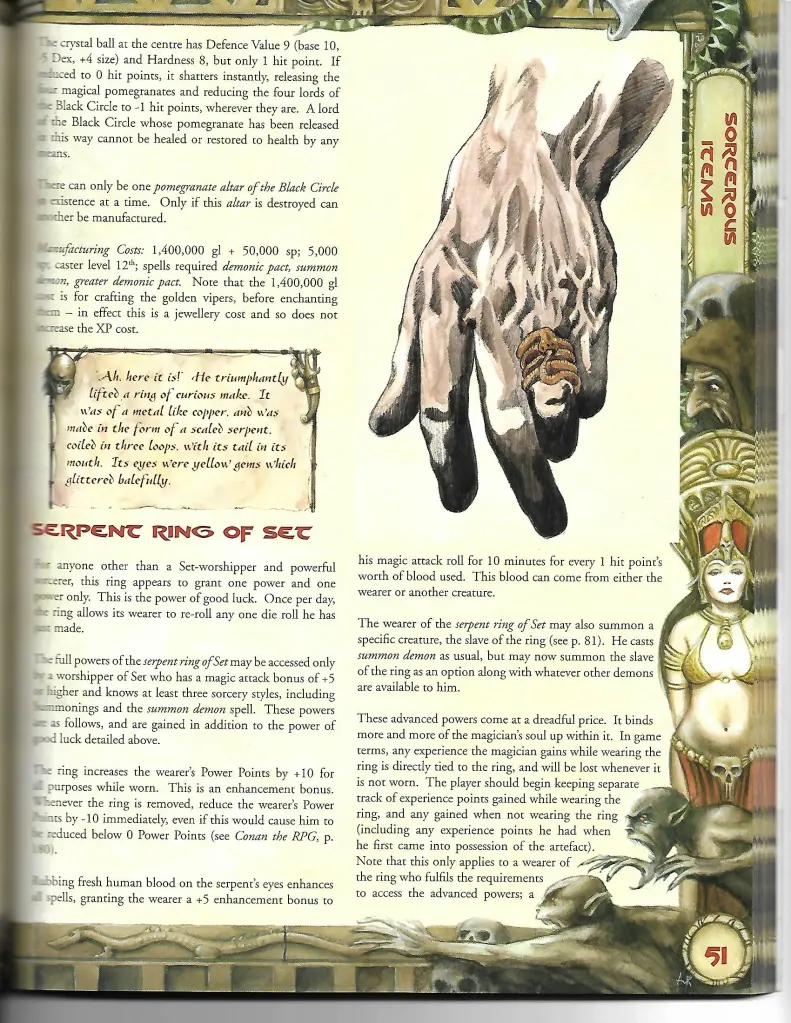
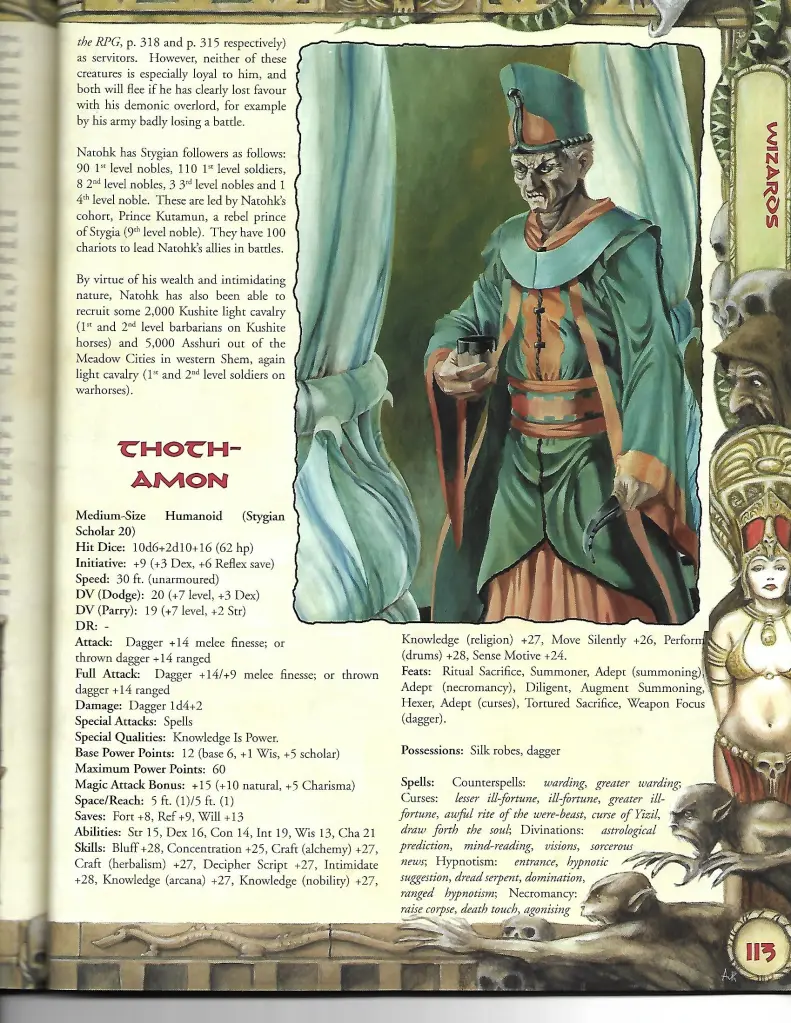
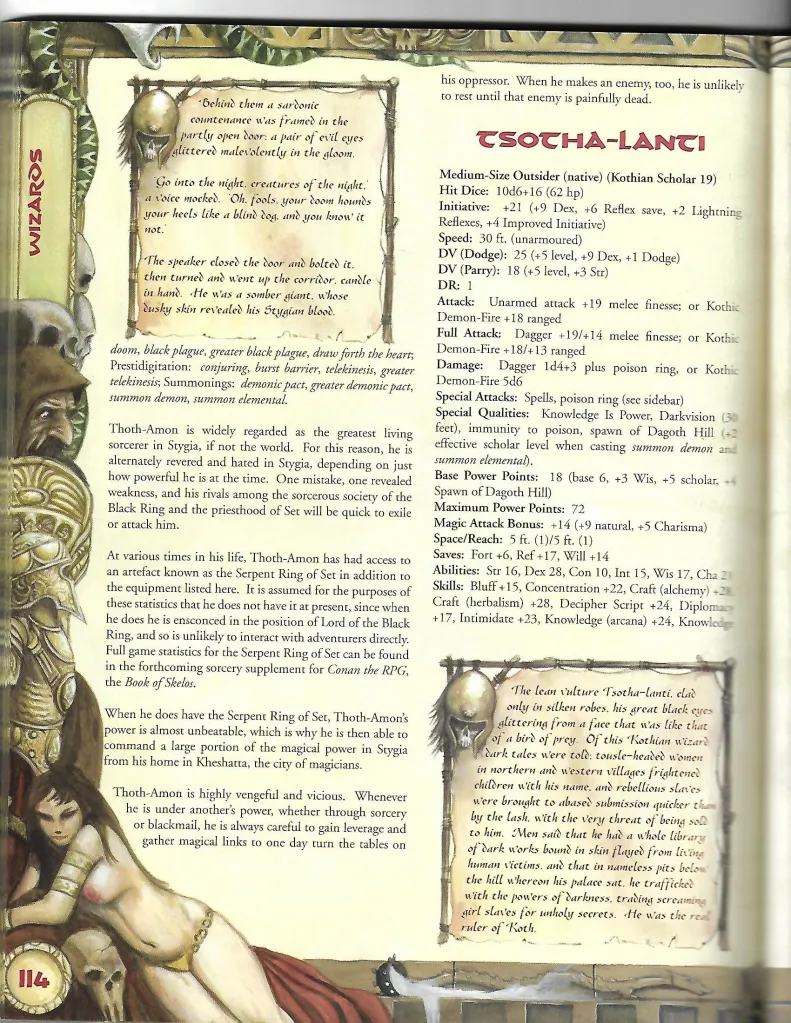
Ian Sturrock created statistics for Thoth-amon in Mongoose Publishing’s The Scrolls of Skelos. The text states that the statistics reflect Thoth-amon without his ring, but he is still a 20th level Scholar and absolutely mighty. Interestingly, Ian Sturrock did not give Thoth-amon any levels in this prestige class. In the same volume, he also created a “Lord of the Black Ring” prestige class and outlined the Serpent Ring of Set for the game. This prestige class gives the character Demonologist as a class feature. Interestingly, Ian Sturrock did not give Thoth-amon any levels in this prestige class. I suspect that is because he intended to include Thoth-amon in the base game book, but it just didn’t happen that way.
In Stygia – Serpent of the South, I offered an alternative version of Thoth-amon, but for whatever reason, I decided not to give him levels in the Lord of the Black Ring prestige class. He’s a straight 20th level Scholar in that book. Although I do not remember, I suspect I did it that way because that is the way Ian Sturrock statted him. I just wanted to correct the notion that he was powerful without his Ring, so the Stygia book includes a much weaker version of the character at 10th level without his Ring, with all the negative effects of Obsession at play. I also wanted to add in new rules from Scrolls of Skelos and Stygia – Serpent of the South and improve upon Ian Sturrock’s description of Thoth-amon’s personality. I also worked on making Knowledge (religion) a more useful skill. In this book, characters could take ranks in their god’s “mysteries” instead of a generic “religion” check. These ranks would affect what the character could do and provide cult-specific benefits at various ranks.
Presented below is my unpublished final version of Thoth-amon. Personally, any RPG statistics of Thoth-amon without making him considerably weaker without his ring is problematic, so I made sure to include Thoth-amon’s statistics without the Ring of Set. Even though you may or may not be interested in his game statistics, you might enjoy the character description.
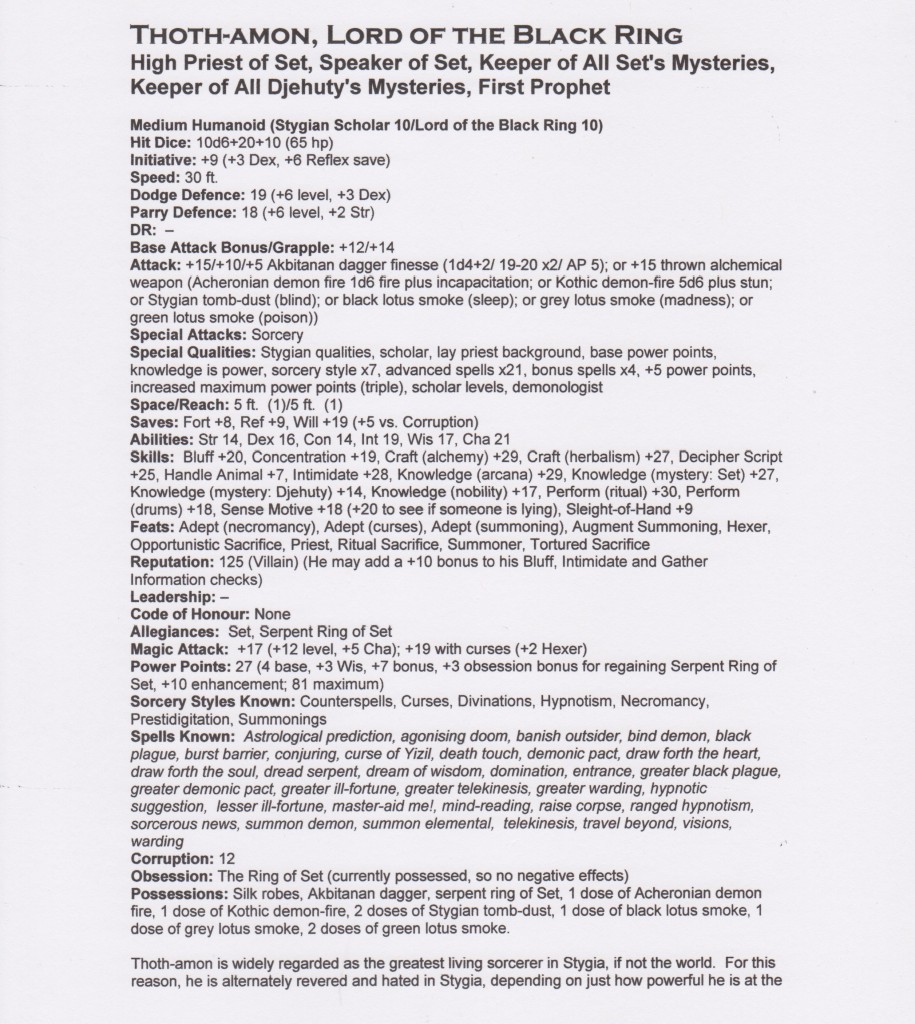
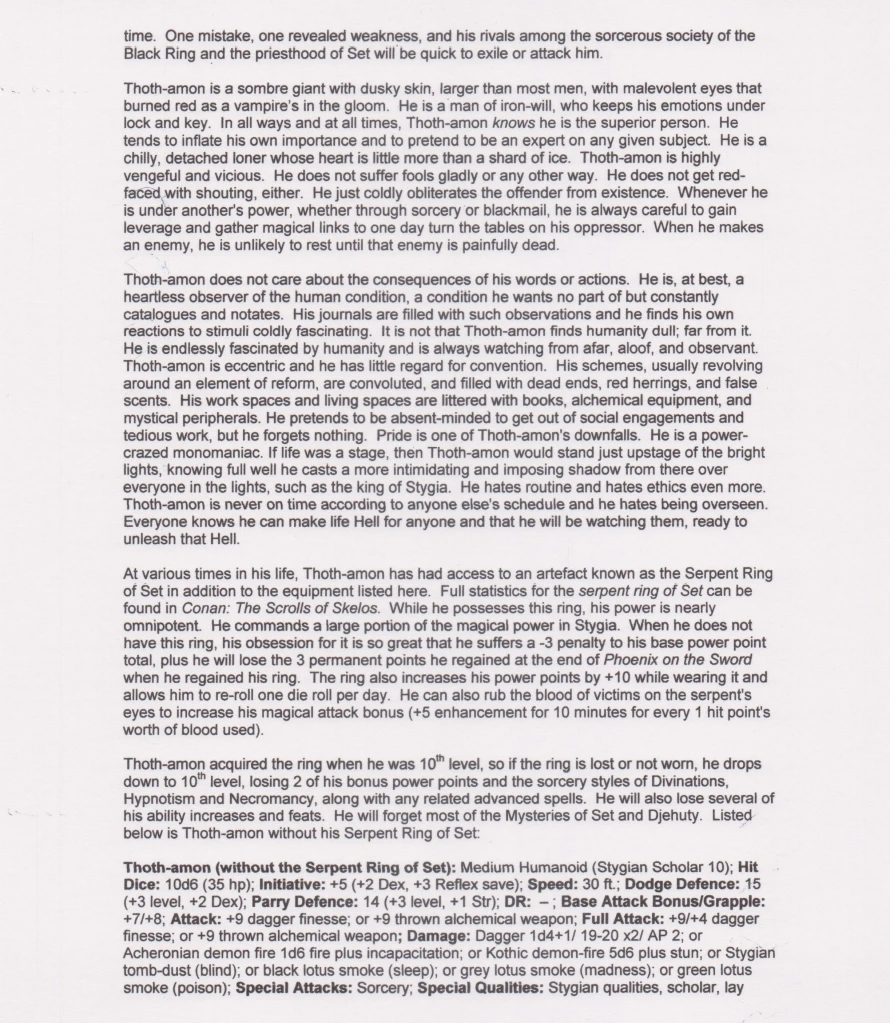
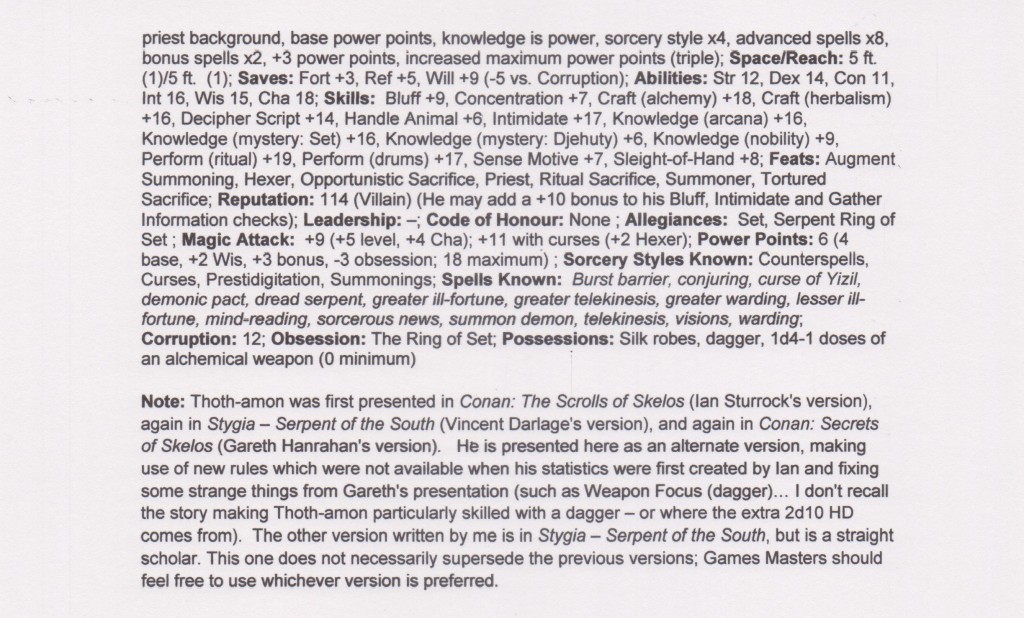
Conan: Adventures in an Age Undreamed Of (Modiphius Entertainment)
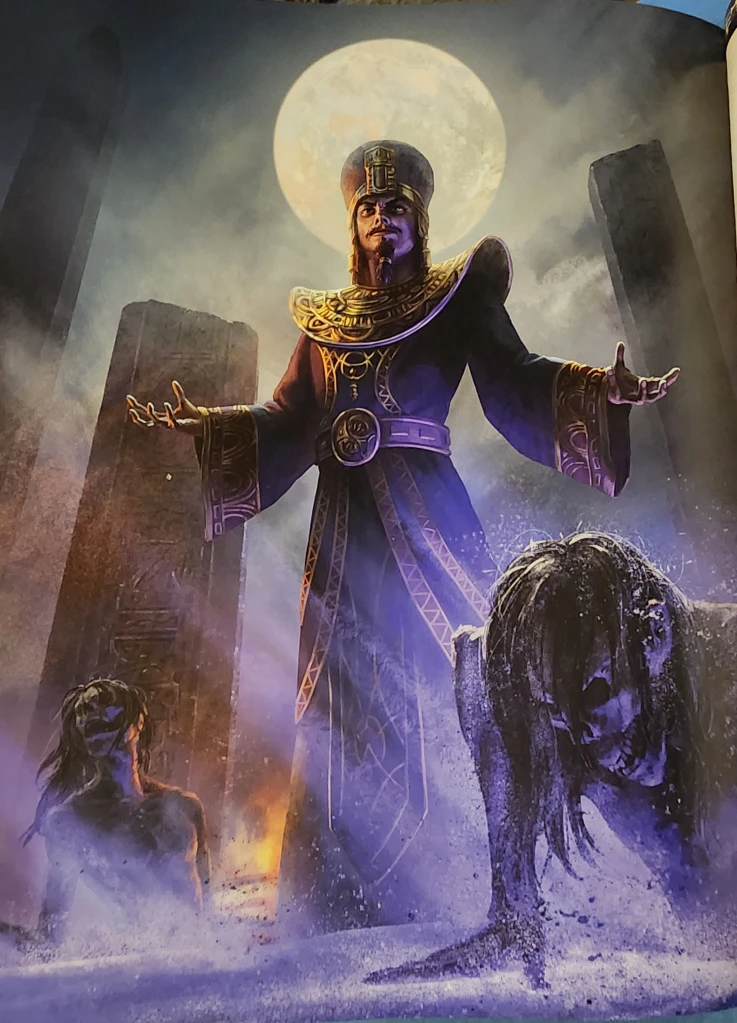
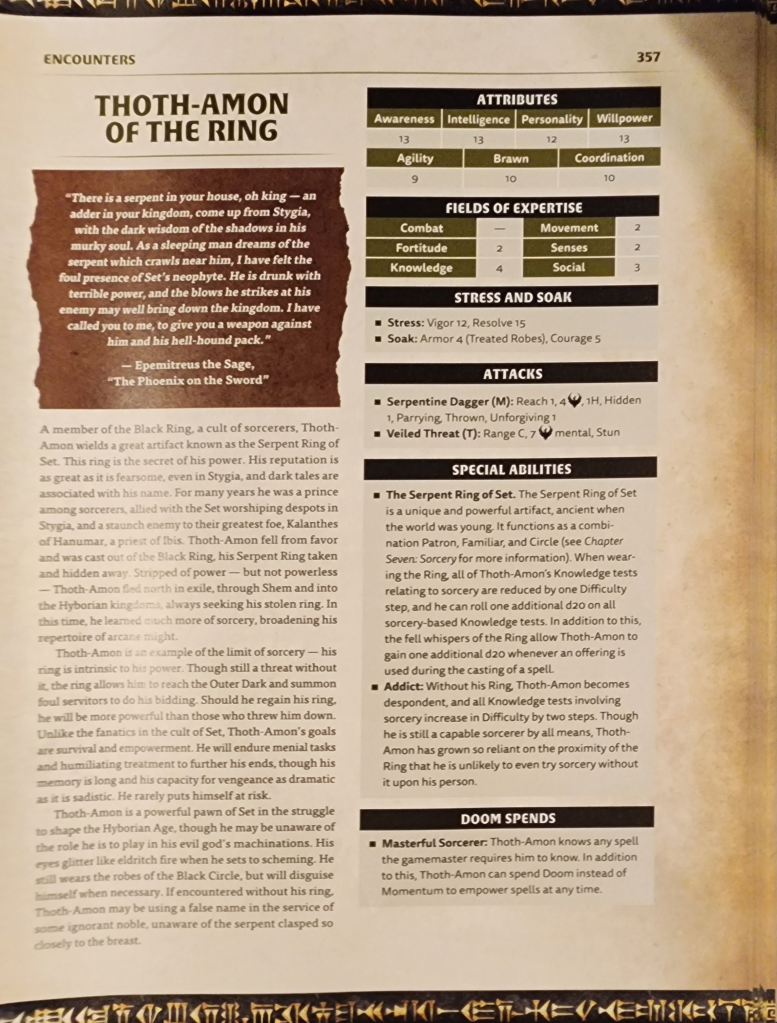

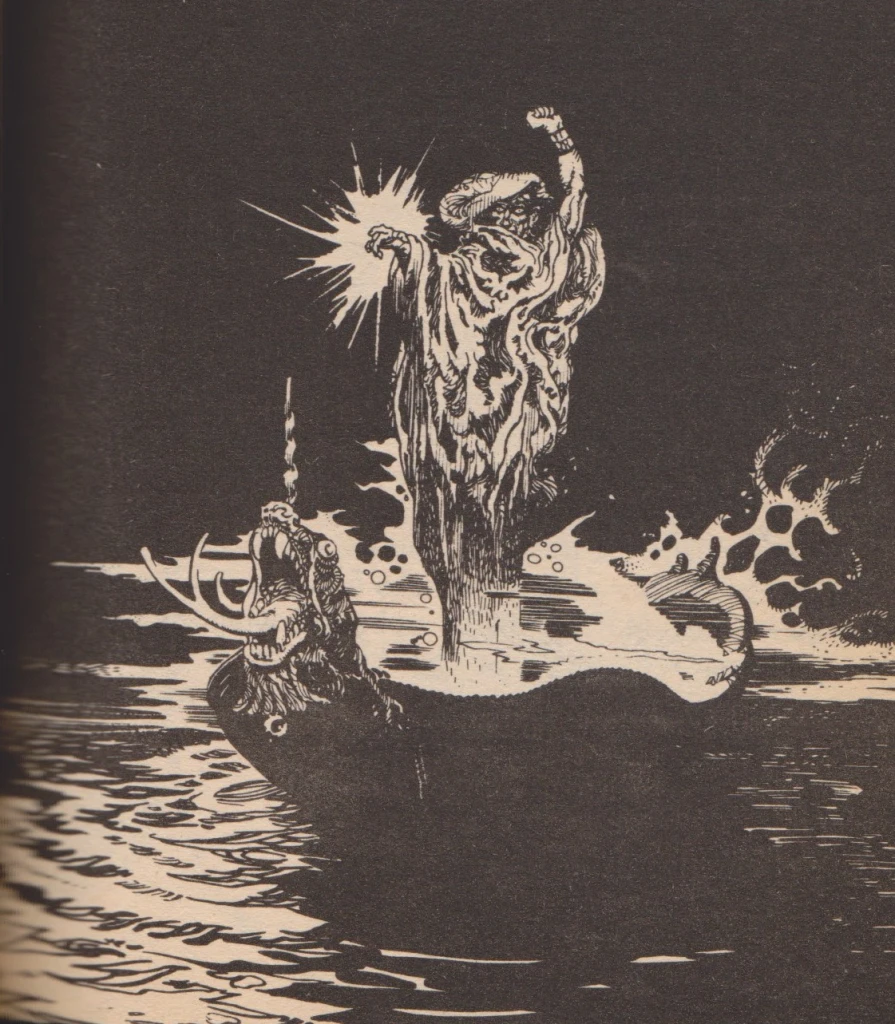
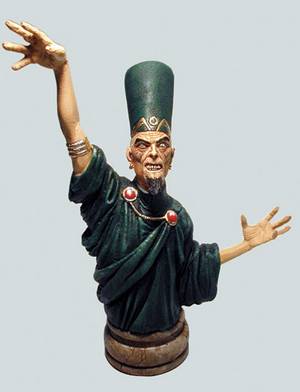
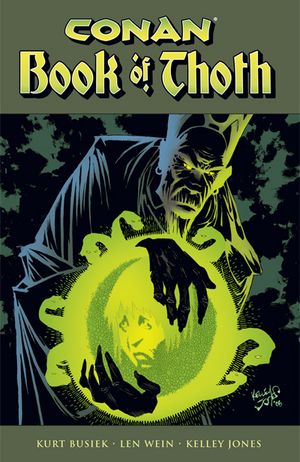
Very informative article.
Thanks. Vincent really knows his stuff.
Pingback: Sensor Sweep: Warhammer, Arkham House, Michael Shea – castaliahouse.com